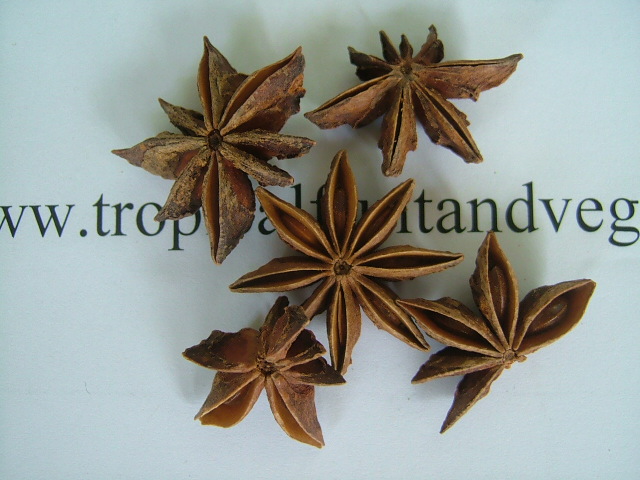| Uses: 86 to 90 of 99 NextPage Go to Page: 1 2 3 4 5 6 7 8 9 10 11 12 13 14 15 16 17 18 19 20 | |

|
Star Anise
Botanical Name: Illicium verum The star shaped fruits are harvested just before ripening. It is widely used in Chinese cuisine, and to a lesser degree in Indian and South Asian cooking. Star anise is an ingredient of the traditional five-spice powder of Chinese cooking. Star anise contains anethole, the same ingredient which gives the unrelated anise its flavour. |

|
Strawberry Guava
Botanical Name: Psidium Cattleianum Strawberry guavas are eaten out of hand. A puree or tart-filling can be made from strawberry guavas. They can also be used to make jelly, jam, butter, paste and sherbet. In Hawaii, they are used to make ade or punch. |

|
Sugar Apple
Botanical Name: Annona squamosa The sugar apple is extremely popular throughout the tropics. It is usually eaten fresh or used to make beverages and shakes. |

|
Sugarcane
Botanical Name: Saccharum officinarum In most countries where sugarcane is cultivated, there are several foodstuffs and popular dishes derived from it. Sugarcane can be consumed raw in cylinders or cubes, which are chewed to extract the juice and the bagasse is spat out. Mostly however, fresh juice is extracted by hand or electrically operated small mills with a touch of lemon and ice which makes a delicious and popular drink.Sugar is made into molasses and used as a sweetener and as a syrup accompanying other foods, such as cheese.Rapadura is a candy made of flavoured solid brown sugar in Brazil, which can be consumed in small hard blocks, or in pulverized form (flour), as an add-on to other desserts.Sugarcane is also used in rum production, especially in the Caribbean. Brazil is a major grower of sugarcane, which is used to produce sugar and provide the alcohol used in making gasohol and biodiesel fuels. |

|
Tamarillo
Botanical Name: Cyphomandra betacea Ripe tamarillos may be merely cut in half lengthwise, sprinkled with sugar and served for eating by scooping out the flesh and pulp. Or the halves may be seasoned and grilled or baked for service as a vegetable. The fruit should not be cut on a wooden or other permeable surface, as the juice will make an indelible stain. The peeled fruit is sliced and added to stews or soups, or served with a sprinkling of sugar and perhaps with a scoop of vanilla ice cream. Seasoned with salt and pepper, the slices can serve as sandwich-filling or may be used in salads. Chopped slices are blended with cream cheese and used as sandwich spread. In New Zealand the fruit is used to make chutneys and pickles. |
| 86 to 90 of 99 NextPage Go to Page: 1 2 3 4 5 6 7 8 9 10 11 12 13 14 15 16 17 18 19 20 | |